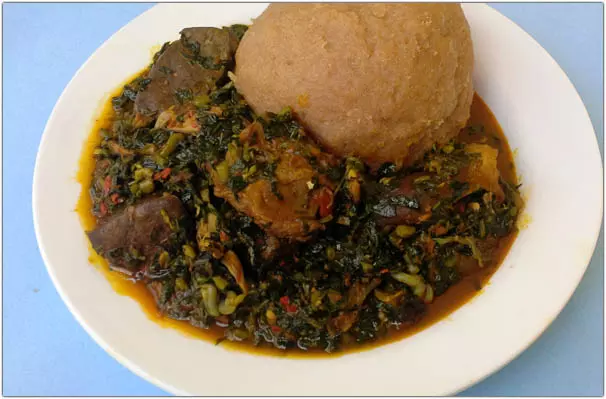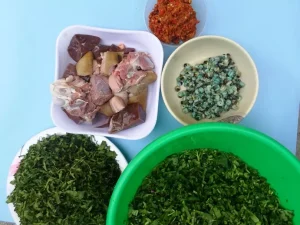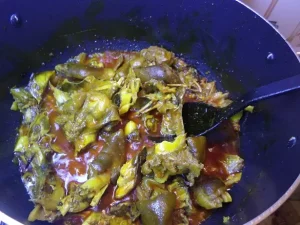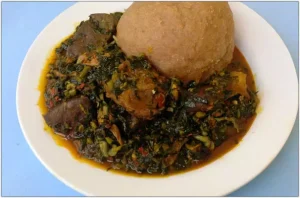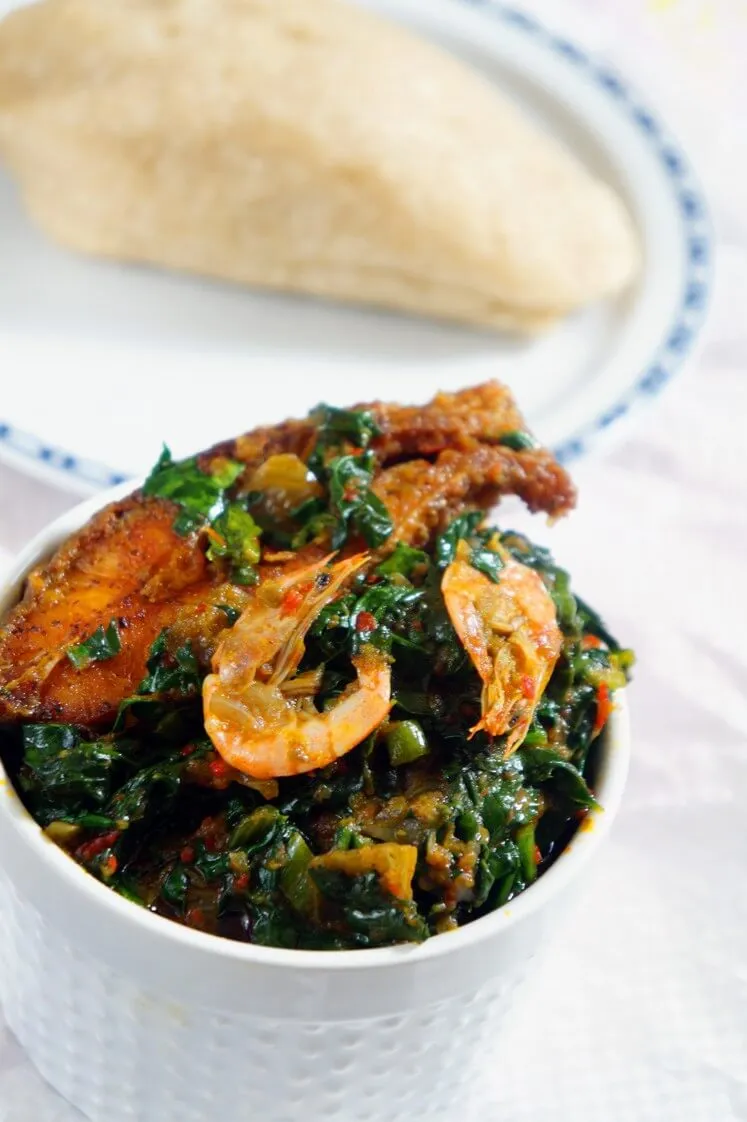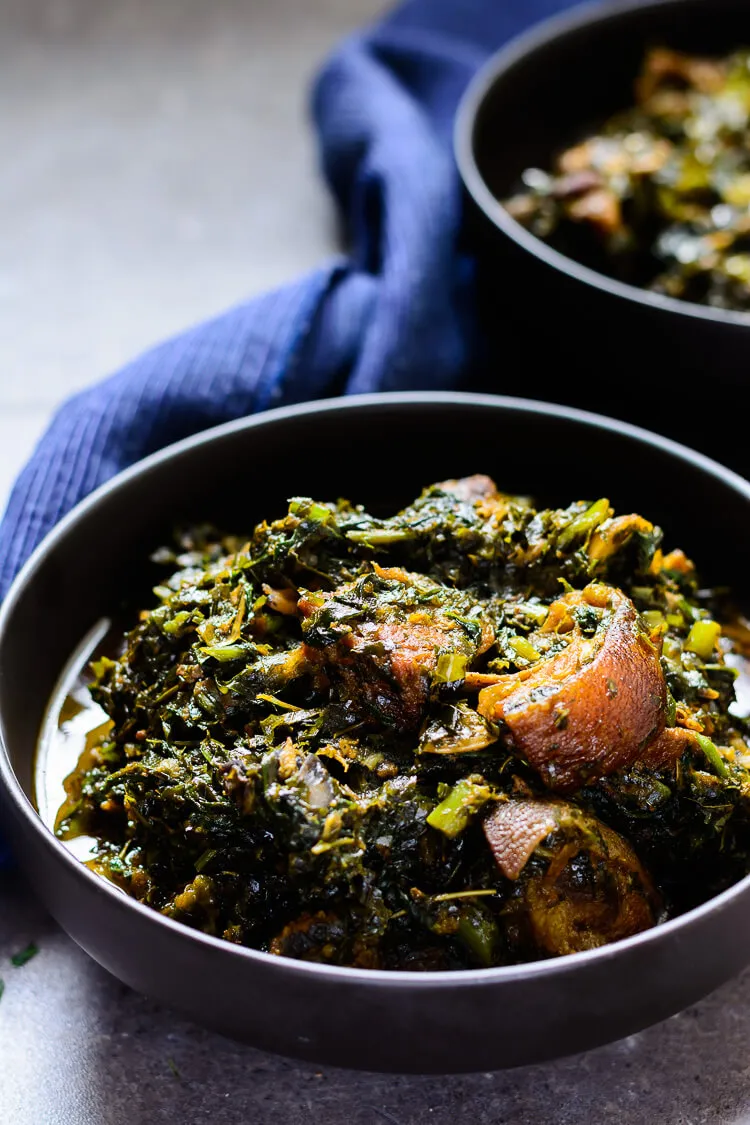If you have been following yummy medley for a while, and have managed to escape a trip to your African market, this Afang soup recipe is going to push you to go there, and trust me, this dish is worth the trip. Get on google and look up “African grocery stores near me”, and get ready to take a trip to flavortown. For Africans already familiar with African grocery stores, or for those who live in the great continent already, this for you should be a simple trip for you. Let me introduce you to my delicious Afang Soup recipe, a leafy vegetable soup commonly associated with Calabar city in Nigeria but with cultural and family roots in the Ibibio and Efik tribes of the riverine areas of the country. These two tribes, which inhabit the Akwa-Ibom and Cross River states in Southern Nigeria feature this soup quite heavily in their cuisine and celebrations but to my knowledge, there are no major differences in their method of preparation.
A little background story about my food history, my mother is from a state in Nigeria called Akwa-Ibom, and the stereotype of women from this state is that they cook the best food in Nigeria. I might be a little biased, but as a half Ibibio (a tribe in Akwa-Ibom state) half Esan (a tribe in Edo state) girl that lived in Lagos with family members from different parts of the country (trust me, my family is quite the diverse group), I can say with full confidence that this stereotype is more likely a fact. My mom and her four sisters, my late grandmother, and pretty much any one from my mother’s side of the family that cooked for us growing up always had the best food. Nothing beats the delicious soups and stews that came from my mom’s side of the family. I remember my disappointment at tasting non-Akwa-Ibom pepper soup, I knew from then on that I was brought up with taste privilege.

Afang soup is one of the delicious dishes to come from my mother’s side of the family. I have since learnt that this is a dish cooked by some Cameroonians as well, as some parts of Cameroon share a border with Akwa Ibom state. There are other dishes that Cameroonians and Cross River/ Akwa-Ibom people share as well, and I will talk about those eventually.
What is Afang Leaf?
Afang leaf also called Eru in Cameroon and Okazi in other parts of Nigeria is a flavorful green leafy vegetable Gnetum africanum, that is commonly grown in West Africa and used in making different soups and stews. Afang is one of the most common leafy vegetables in Nigeria and is also found predominant in Cameroon, Gabon, Congo and Angola.
Afang soup, made by the Efik and Ibibio people that live mostly in the coastal states of Cross Rivers and Akwa Ibom (2 neighboring states out of the six Southern states that constitute the natively nicknamed ‘South South’ regions of Nigeria) is a stew made with Afang leaves and another common green leafy vegetable natively called waterleaf. Afang soup is quite the staple in the coastal cities of South Nigeria and is heavily featured in ceremonies and festivals of the Ibibio, Efik and other residents of the ‘South South’, including weddings, christening of newborn babies or even at funerals. Because Cross River and Akwa-Ibom states are riverine, most stews and soups originating from these states are made with some type of seafood and might include a variety of assorted meats, as featured in this recipe.
How to Prepare Afang Soup
Our stews and soups can be surf and turf style (like in this recipe), but most Efik or Ibibio stews and soups that are not vegan, have seafood in it. In this afang soup recipe, I use shelled clams and small shelled apple snails, but you could use smoked dried fish, periwinkles, fresh or dried shrimp, crabs, oysters, or any other type of seafood you enjoy.
List of Ingredients
- 2 lbs (about 907 grams) Malabar Spinach aka Water leaf- While waterleaf can be substituted with conventional spinach, its best substitute is lamb’s leaf lettuce.
- 57 g or 2 oz dried Afang leaves (may be labeled Okazi/Eru in the African store) – Afang leaves have no substitute that I know of, so if you have never ventured into an African grocery store, you will need to if you want to try this Afang soup recipe. Just ask for Okazi or Eru. In a pinch, Afang leaves are also available online for purchase, but I encourage you to go to an African store if you can.
- 3 lbs (About 1.4 kg) Goat meat cut into large bite size cubes – Feel free to omit this and all animal products if you would prefer a vegan version of this Afang soup recipe .
- ½ cup of cooked shelled Apple snails
- ½ cooked shelled Clams
- ½ cup palm oil
- 2 Red onions
- 2 Scotch bonnet peppers substitute with habanero peppers
- 4 tbsp Ground smoked dried shrimp aka crayfish
- 3 tsp Chicken Bullion
- 2 tbsp cayenne pepper/ crushed red pepper flakes optional
- Salt to taste
Prep the Onions and Peppers
Slice both onions and scotch bonnet peppers, and set them aside.
Braise the Goat Meat
On low- medium heat in a large stock pot, braise the goat (or your choice of ) meat with the one of the onions, scotch bonnet peppers, 1 tsp bouillon and 1 tsp salt for 30 minutes or until the meat is tender.
Half way into braising the goat meat, add ½ a cup of water and stir the meat to prevent in from burning. Keep the pot covered at all times during the braising process. Once the meat is tender and is done braising. Set aside.
Prep the Water Leaf/Malabar Spinach
While the meat is braising, wash your Malabar spinach in cool water to get rid of sand and dirt. Pick off the tough stems, but save the tender stems and leaves. Chop and set aside.
Prep the Afang Leaves
In a food processor, roughly grind the afang leaves just to break it up a little. Afang leaves are mostly sold in the African store already shredded, but you can break it up a little more using a food processor/ mortar and pestle so the shreds are not as long.
Cooking the Soup
In a deep pot heat up the palm oil on medium heat (be careful not to over heat the oil on high heat) and sauté the other sliced onion for 10 minutes until it is starting to get caramelized.
Add in the snails and clams, and continue to sauté for another 5 minutes.
Add in the braise goat meat and reserve the braising liquid. It is a very flavorful stock, and will still be used.
Add in 2 teaspoons of bouillon, crayfish, and if you are spice inclined, cayenne pepper, stir, then add in the chopped water leaf.
Just like regular spinach, the water leaf will look like a lot at first, but wilt down in a few minutes. once the water leaf starts to wilt, add in the Afang leaves and stir.
Add about 1 cup of the braising liquid to the stew, turn down the heat to low, and continue cooking with the pot covered for another 10 minutes.
After 10 minutes, taste the stew for seasoning and adjust the salt if necessary.
Turn the heat off and allow the stew to sit for 5 minutes, then serve hot
Afang soup goes best with many types of firm fufu. It is great with Eba, pounded yam, ground rice, oat fufu, and lafun. I do not prefer Afang with softer textured fufu like amala or elubo (a yam based fufu), but it is still delicious either way. If you do not have access to fufu at all, you can eat Afang with boiled rice, but nothing beats Afang with a good firm fufu.
Frequently Asked Questions
Can I substitute water leaf for spinach?
You can use spinach as a substitute for water leaf/ malabar spinach. It tastes a little different from traditional when cooked with typical spinach, but it is a fair substitute in a pinch. If you have access to different varieties of spinach, I would encourage using a very water rich variety.
Why is Afang Soup called a Calabar Soup?
Calabar is the capital city of Cross Rivers state and one of the thriving and more popular tourist locations in Nigeria. As a result of Calabar city’s popularity, many visitors and even Nigerians have associated the indigenes, culture and cuisine of the surrounding area with the name of the town (in the same way Lagos finds itself associated with many aspects of Yoruba culture). This association results in the colloquial notation of Afang as a ‘Calabar soup’ even though it’s roots go much deeper wider and its ubiquity extends far wider even, as discussed before, as far as the neighboring cities of Cameroon.
What are the Health Benefits of Afang Leaf?
Like all dark green leafy vegetables, Afang (even the dried version), is low in fat, and rich in vitamin C, potassium, sodium, iron and magnesium. Afang however is particularly rich in Vitamin A, and very high in dietary fiber (higher than typical leafy greens like spinach).
What are the benefits of Afang soup in pregnancy?
I have highlighted this particular health benefit of Afang because it has played a key role in providing nourishment for pregnant women in parts of Nigeria and Cameroon that do not have access to certain essential prenatal supplements. Since Afang is particularly rich in folic acid and vitamin A, it has been significant in providing adequate nourishment for both mother and unborn baby. Feel free to check out this published study to get more information about the health benefits of Afang soup and read a little more about its benefits in pregnancy.
Afang Soup Recipe
Afang soup, eaten by Efik and Ibibio people of Nigeria is a delicious stew made with Afang leaves and a leafy vegetable called waterleaf.
Prep Time20minutes mins
Cook Time1hour hr
Total Time1hour hr 20minutes mins
Course: Main Course, Side Dish
Cuisine: Cameroonian, Nigerian
Servings: 8
Calories: 362kcal
Author: Yummy Medley
- 2 lbs Water leaf or regular/Malabar spinach
- 57 g 2 oz dried Afang leaves (may be labeled Okazi/Eru in the African store)
- 3 lbs Goat meat cut into large bite size cubes
- ½ cup of cooked shelled Apple snails
- ½ cooked shelled Clams
- ½ cup palm oil
- 2 Red onions
- 2 Scotch bonnet peppers substitute with habanero peppers
- 4 tbsp Ground smoked dried shrimp aka crayfish
- 3 tsp Chicken Bullion
- 2 tbsp cayenne pepper/ crushed red pepper flakes optional
- Salt to taste
-
Slice both onions and scotch bonnet peppers, and set them aside.
-
On low- medium heat in a large stock pot, braise the goat meat with the one of the onions, scotch bonnet peppers, 1 tsp bullion and 1 tsp salt for 30 minutes or until the meat is tender.
-
Half way into braising the goat meat, add ½ a cup of water and stir the meat to prevent in from burning. Keep the pot covered at all times during the braising process.
-
While the meat is braising, wash your water leaf in cool water to get rid of sand and dirt. Pick off the tough stems, but save the tender stems and leaves. Chop and set aside.
-
in a food processor, roughly grind the afang leaves just to break it up a little. Afang leaves are mostly sold in the African store already shredded, but you can break it up a little more using a food processor/ mortar and pestle so the shreds are not as long.
-
Once the meat is tender and is done braising. Set aside.
-
In a deep pot heat up the palm oil on medium heat (be careful not to over heat the oil on high heat) and sauté the other sliced onion for 10 minutes until it is starting to get caramelized.
-
Add in the snails and clams, and continue to sauté for another 5 minutes.
-
Add in the braise goat meat and reserve the braising liquid. It is a very flavorful stock, and will still be used.
-
Add in 2 teaspoons of bullion, crayfish, and if you are spice inclined, cayenne pepper, stir, then add in the chopped water leaf.
-
Just like regular spinach, the water leaf will look like a lot at first, but wilt down in a few minutes. once the water leaf starts to wilt, add in the Afang leaves and stir.
-
Add about 1 cup of the braising liquid to the stew, turn down the heat to low, and continue cooking with the pot covered for another 10 minutes.
-
After 10 minutes, taste the stew for seasoning and adjust the salt if necessary.
-
Turn the heat off and allow the stew to sit for 5 minutes, then serve hot


